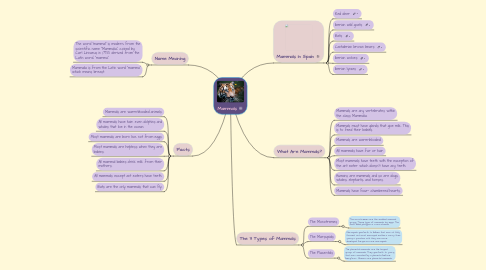Mammals
por Eva Lacatus


1. Name Meaning
1.1. The word "mammal" is modern, from the scientific name "Mammalia", coined by Carl Linnaeus in 1758, derived from the Latin word, "mamma".
1.2. Mammalia is from the Latin word "mamma" which means breast.
2. Facts
2.1. Mammals are warm-blooded animals.
2.2. All mammals have hair, even dolphins and whales that live in the ocean.
2.3. Most mammals are born live, not from eggs.
2.4. Most mammals are helpless when they are babies.
2.5. All mammal babies drink milk from their mothers.
2.6. All mammals except ant eaters have teeth.
2.7. Bats are the only mammals that can fly.
3. Mammals In Spain
3.1. Red deer
3.2. Iberian wild goats
3.3. Bats
3.4. Cantabrian brown bears
3.5. Iberian wolves
3.6. Iberian lynxes
4. What Are Mammals?
4.1. Mammals are any vertebrates within the class Mammalia.
4.2. Mammals must have glands that give milk. This is to feed their babies.
4.3. Mammals are warm-blooded.
4.4. All mammals have fur or hair.
4.5. Most mammals have teeth with the exception of the ant eater which doesn't have any teeth.
4.6. Humans are mammals and so are dogs, whales, elephants, and horses.
4.7. Mammals have four- chambered hearts.
5. The 3 Types of Mammals
5.1. The Monotremes
5.1.1. The monotremes are the smallest mammal group. These type of mammals lay eggs. The duck-billed platypus is a monotreme.
5.2. The Marsupials
5.2.1. Marsupials give birth to babies that are not fully formed, and most marsupial mothers carry their young in pouches until they are more developed. Kangaroos are marsupials.
5.3. The Placentals
5.3.1. The placental mammals are the largest group of mammals. They give birth to young that are nourished by a placenta before being born. Humans are placental mammals.
